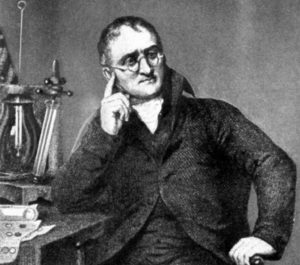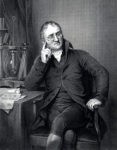Atom is a part of particle of a substance which is gas, liquid or solid (metal). The word of atom firstly punctuated by a philosopher named Democritus. Atom model is an illustration of atom based on theoretical studies that is supported by experiment. The weaknesses of Democritus atom model is it is not supported by experiment so it cannot be acceptable.
The concept of atomic model which is strengthen by experiment is a picture of basic particle arrangement which revealed by John Dalton (1966-1844) who was a teacher in Manchester, England. The model of atom is revealed in his book New System of Chemical Philosophy I in 1803. Here is also Chemistry Models of Atoms
Dalton Atomic Theory
 According to John Dalton the atom is like a solid ball. Dalton states that the substance consists of atoms that can not be divided again. The explanation of Dalton’s theory is as follows.
According to John Dalton the atom is like a solid ball. Dalton states that the substance consists of atoms that can not be divided again. The explanation of Dalton’s theory is as follows.
- The element consists of particles that can not be divided again. Atoms in chemical reactions can not be changed into other elements. It can not be destroyed much less created.
- All atoms present in similar elements have identical properties, sizes and masses.
- Atoms of different elements of the type will have different characters.
- Compounds are formed more than a combination of one element type.
Atoms can join each other. Chemically forming molecules with simple comparisons. Here is also Postulates of John Dalton
Here are advantages and disadvantages of Dalton’s atomic theory:
Advantages of Dalton Atomic Theory
- We can explain the laws of chemical combination with all possibilities based on theory.
- The first person to recognize the molecular differences of elements and compounds.
- Ability to explain the law of conservation of mass by using Dalton atomic theory. Therefore John Dalton is considered as father of the modern atom theory.
Read also :
Disadvantages of Dalton Atomic Theory
- Atoms that are declared undivided in the future may be proven that the statement is false. Given the assertion that the atom can be subdivided into electone (negative charged particles), neutrons (neutral charged particles) and protons (positive charged particles). An experiment proves that its effect on chemical reactions is very big.
- Dalton’s statement of atoms of the same element has similarities in all things both the character, size and mass and atoms of different elements will be different in all things. The fact can be refuted by the discovery that there are several different elements of mass and density such as atoms. Atoms of the same element have different periods called isotopes. For example chlorine has 21 isotopes with number Mass 35 and 37 sma.
- Failure to explain allotropes due to charcoal, graphite and diamonds of the same element hence different character can not be explained in detail.
- To explain the atoms of different elements joining in a simple number ratio to form a compound when it does not apply to complex organic compounds such as sugar C12H22O11
5. Different atomic claims will different in all things, but in some cases this is refuted by the discovery of different elements having the same atomic mass. The same mass of atoms can be owned by two different elements such as Argon (Ar) and Calsium (Ca) which is worth 40. The condition is called isobar.
That’s the advantages and disadvantages of Dalton’s atomic theory. While Dalton’s theory has many shortcomings, he encouraged other scientists to develop a better and perfect atomic model theory.
The atomic theory of dalton is the embrio of modern atomic theory accompanied by experiments, although some are undeniable. That is the description of the basic theory of Dalton atomic model and its advantages and disadvantages. Hopefully it can be useful and spur us to be a better atomic theory developer.
Also read: Basic Laws of Chemistry

